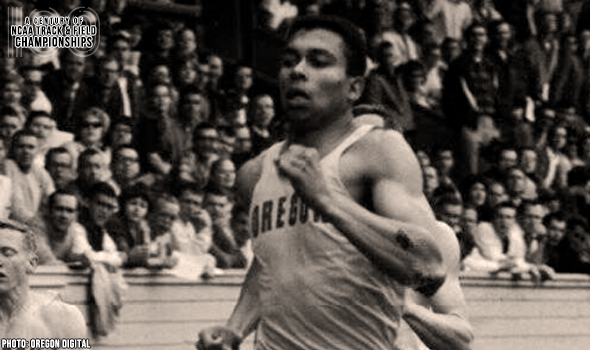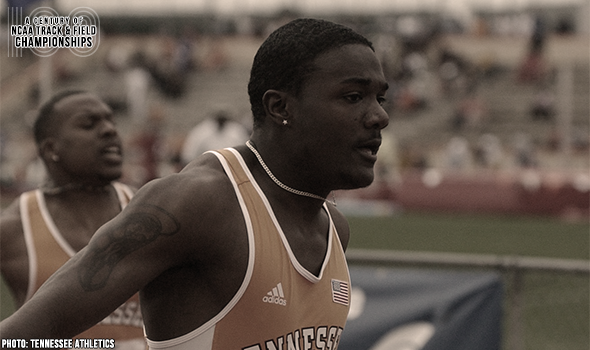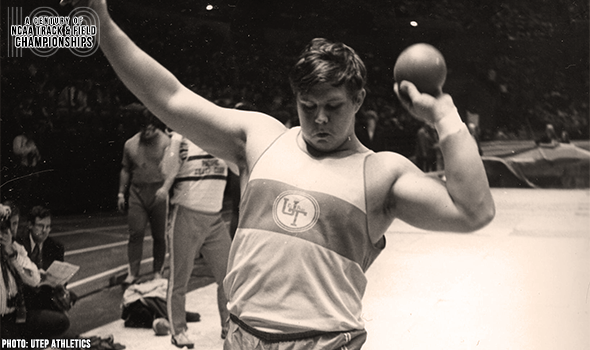
Oregon’s Jerome Sprinted To NCAA Glory
If ever a meet could have used photo-finish timing, it was the 1964 NCAA Outdoor Track & Field Championships.
The 5000 and 400 were both ruled deadlocks, but those were with merely two runners inseparable.
The 100-meter final saw three sprinters crossing the line at almost the same instant: Harry Jerome of Oregon, Edwin Roberts of North Carolina Central and Trenton Jackson of Illinois.
It took almost an hour to sort the finish, but when they did, Jerome was ruled the victor in 10.1. Roberts (second) and Jackson (third) were also credited with that same mark as well.
“Honestly, that’s one I’d hate to judge on,” Jerome said about the finish to Dick Leutzinger of the Eugene Register-Guard. “Usually I know when I win or lose. I’d hate to say on that one.”
While the 10.1 was a meet and collegiate record, it wasn’t a PR for Jerome. He still owned a share of the world record of 10.0 that he set in the summer after his freshman season back in 1960.
Jerome was a Canadian prodigy who came from great lineage. As a high school standout in North Vancouver, British Columbia, he broke a 31-year-old national record in the 220 yards. And many knew his grandfather, John Armstrong Howard, who was the first Black athlete to represent Canada in the Olympic Games.
The fact that Jerome was even running in 1964 – near his best, let alone at all – was a comeback story for the ages. Jerome tore his quadriceps tendon in the fall of 1962 at the British Commonwealth Games and the seriousness of the injury led many to believe that he would never run again. He didn’t believe that and a little over a year later, he opened the 1964 season by equaling the world indoor best in the 60-yard dash with his time of 6.0.
Then at the 1964 NCAA Championships, Jerome doubled back in the 200, taking third to lead Oregon to its second team title in three years – both at Hayward Field. The Ducks won their first national title in 1962 when Jerome won the 220 yards and was runner-up in the 100.
Not long after that, Jerome went to the Tokyo Olympic Games, where he earned his lone Olympic medal – a bronze in the 100.
Jerome died in 1982 of a brain aneurysm at age 42. In 1984, the Labatts Classic held in Burnaby was renamed the Harry Jerome Classic and in 1988 a statue of him was erected in Vancouver’s Stanley Park.
The NCAA and collegiate track & field will mark a momentous milestone in the spring of 2021 -- the 100th anniversary of the NCAA Championships and with that, the NCAA Track & Field Championships. In June 1921, the University of Chicago hosted the first track & field championships in NCAA history.
This point can’t be emphasized enough: Not only was the event the first for NCAA track & field, but the first championships for any sport under the sponsorship of the NCAA.
To celebrate, over each of the next 365 days, the U.S. Track & Field and Cross Country Coaches Association (USTFCCCA) will celebrate moments, student-athletes, and coaches that have made a century’s worth of championships special. From humble beginnings to important historical milestones to the modern-day, collegiate track & field has evolved with the American society.
The 2021 edition of the NCAA Division I Outdoor Track & Field Championships begin with preliminary round action on May 27-29 in Jacksonville, Fla., and College Station, Texas. The championships final site and culmination of the celebration is slated for June 9-12, 2021 at the newly rebuilt Hayward Field in Eugene, Ore.

Providence’s Smith Left Field In The Dust
Kim Smith won the 5000 meters at the 2004 NCAA Division I Outdoor T&F Championships by 36.04 seconds in 15:48.86 for the largest margin of victory in meet history.

Gatlin Doubled Up In Back-To-Back Years
Justin Gatlin completed back-to-back 100-200 doubles at the NCAA DI Outdoor T&F Championships in 2001 & 2002. He went 10.08/20.11 & 10.22/20.18 in those respective years.

UTEP’s Hoglund First To Crack 70-Foot Barrier
Hans Hoglund was the first man to touch the 70-foot barrier in the SP at the NCAA DI Outdoor T&F Championships. He also won by more than 4 feet with his 21.33m (70-0) heave in 1975.

LSU’s Hobbs Couldn’t Be Caught In 2018
Aleia Hobbs anchored LSU to a 4×100 relay MR of 42.25 & then doubled back to win the 100 by 0.23 seconds at the 2018 NCAA DI Outdoor T&F Championships.

Michael Johnson Had 1990 NCAAs To Remember
All eyes were on Michael Johnson of Baylor in the 4×400-meter relay at the 1990 NCAA Division I Outdoor Track & Field Championships.

Riley Completed Unprecedented Double In 2012
Andrew Riley completed the only 100-110H double in NCAA DI Outdoor T&F Championships history in 2012. Riley won the 100 in 10.27 & then captured the 110H crown in 13.53

Leatherwood Rolled To Back-To-Back 400 Titles
Lillie Leatherwood won back-to-back 400-meter titles at the NCAA Division I Outdoor T&F Championships in 1986 & 1987. She set a meet record of 50.90 in that second year.

Iowa’s Jones Made Distance History
Charles “Deacon” Jones set a meet record in the 2-mile at the 1957 NCAA Outdoor Track & Field Championships with his time of 8:57.6.

Locke Doubled Up On Sprint Titles In 1926
Roland Locke entered the 1926 NCAA Outdoor T&F Championships as the WR holder in the 220. He left with the meet record in that event (20.9) & also won the 100 in 9.9.

McLain Bounded To All-Conditions TJ Best
Erica McLain won the triple jump at the 2008 NCAA DI Outdoor Track & Field Championships by nearly two feet! McLain bounded to an all-conditions meet best at 14.60m (47-11).

